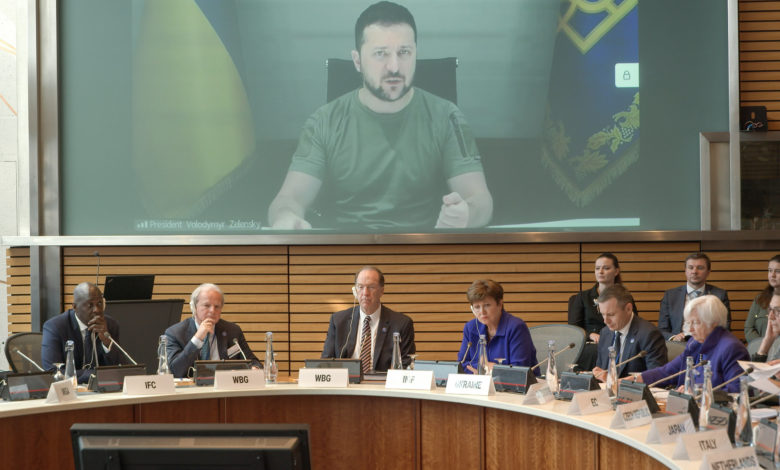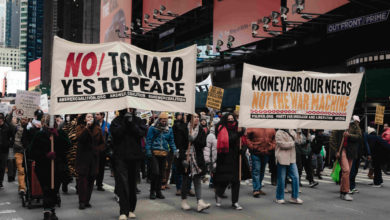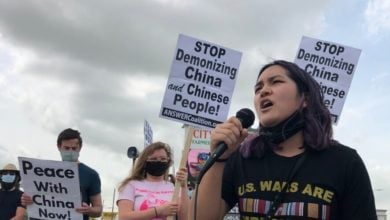
Photo: President of Ukraine Volodymyr Zelensky speaks at the Second Ministerial Roundtable Discussion for Support to Ukraine, co-chaired by representatives from the IMF and World Bank. Credit: World Bank Photo Collection
With billions of dollars in outstanding debt, Ukraine is one of the International Monetary Fund’s top borrowers. On top of this, it is estimated that the government will owe the IMF an additional $360 million in surcharge fees in 2023. While Ukraine, in the aftermath of the Soviet Union’s collapse, adopted a market economy with some level of government intervention, IMF-driven neoliberalization thoroughly intensified after the 2014 U.S.-backed Maidan coup. This process has aggressively escalated even more so following the Russian invasion. The purpose of IMF lending in Ukraine — as with all borrowing countries — is to force the state to implement structural adjustment policies and austerity measures, such as the dismantling of labor and trade regulations or slashing of social programs and government spending, to attract and open up the country to foreign investment.
The role of multilateral institutions like the IMF is an important but under-discussed factor driving the U.S. capitalist class’s support for the war in Ukraine. Since the Russian invasion in February 2022, the IMF’s grip on the country has only tightened. Now thoroughly embroiled in a war, the Ukrainian government has even less leeway to reject or negotiate the structural adjustment policies and economic reforms demanded by the financier. In this way, just as it does in every borrowing country, the IMF serves as an imperialist instrument of western capital in Ukraine, now using the war as pretext for accelerating economic “shock therapy” and penetration of the country by Wall Street and other foreign investment interests so that they can buy off every last asset as the country is destroyed by war.
Post-Soviet collapse and lead-up to Maidan
One of the worst amid the post-Soviet collapse, Ukraine suffered the second largest drop in per capita income out of all the former Soviet socialist republics, with income per person falling 60% from 1990 to 1997. In light of this economic devastation, Ukraine has repeatedly turned toward aid packages from the IMF to prop up its struggling economy: the creditor loaned $3.5 billion to the Ukraine government after the dissolution of the Soviet Union, another $2.2 billion in 1998 (this amount was later increased), another $600 million in 2004, and yet another $16.4 billion in 2008.
The IMF has long been interested in opening up Ukraine, the poorest country in Europe, to western corporate interests — particularly its agricultural sector. Known as the “breadbasket of Europe,” Ukraine is the fourth largest exporter of corn and the fifth largest exporter of wheat, home to fertile black soil ideal for yielding high volumes of grain. It is with this eye toward Ukraine as a site of agribusiness investment that lenders like the IMF and World Bank demand the implementation of economic reforms that favor western corporations — such as slashing social services, lowering corporate taxes, and the chipping away at labor laws and environmental regulations — as requirements for their aid packages.
In fact, the World Bank provided Ukraine with an $89 million loan as part of its Ukraine Rural Land Titling and Development Project, which was completed in 2013 — an initiative which sought to “privatize state lands and communal farm enterprises, allocate land parcels and issue deeds to land parcel owners, and establish an electronic land cadastre.”
In 2010, the IMF was set to deliver another $15 billion aid package, conditional upon the lifting of gas subsidies, as well as tax and pension reforms. However, the loan was put on hold after then-President Viktor Yanukovych vetoed some of these austerity measures. The following year, in 2011, the same aid package was stalled again after the Yanukovych government failed to pass a pension reform bill that aimed to slash public spending by raising the age of retirement for women from 55 to 60 years old. Though Parliament was able to pass the massively unpopular bill a few months later, unfreezing the loan, Yanokovych’s reluctance and delays in pushing through the necessary austerity measures such as these would have dire consequences for his administration.
The pivotal moment in Ukraine’s current crisis occurred at the end of 2013, when Yanukovych was expected to sign an EU trade agreement deal, which was tied to a $17 billion IMF loan. Ukraine was set to plunge into default, and the deal would have integrated it more fully into the western economic sphere. However, Russian President Vladimir Putin stepped in and offered a more attractive aid package in the form of a $15 billion loan, plus a 33% discount on Russian natural gas. Shortly after Yanukovych signed the deal with Putin, he was ousted in the U.S.-backed Maidan coup in 2014 and fled the country in exile.
Post-2014: The aftermath of Maidan, neoliberalization intensifies
Since 2014, international financial institutions have taken the opportunity to even further intensify neoliberalization in Ukraine. Immediately after the coup, the newly U.S.-installed Prime Minister Arseniy Yatsenyuk signed the EU trade agreement into place and resumed talks with the IMF. In exchange for the $17 billion loan, the institution forced the Ukrainian government to reform its natural-gas price subsidies. As a result, Ukrainian citizens saw a 50% jump in natural gas prices. Other reforms enacted as conditions of the loan included raising property taxes, freezing the minimum wage, and cutting wages for public sector workers.
The World Bank also announced a $3.5 billion loan to Ukraine after the coup, the conditions of which included scaling back on public provisions of energy and water and a stipulation that the government was to “remov[e] restrictions that hinder competition and by limiting the role of state ‘control’ in economic activities”.
And in August of 2014, Yatsenyuk — a former banking executive — introduced a bill cutting taxes on businesses and announced plans to privatize all state-owned enterprises, except for essential ones. The next year, in July of 2015 at the first U.S.-Ukraine Business Forum, the prime minister practically begged conference participants, saying, “We ask American businesses to participate in a large-scale privatization of Ukrainian state-owned enterprises … We have similar interests, and we will definitely succeed in this. So, please, consider the idea to invest in Ukraine and to participate in the privatization.”
And in another step toward attracting agribusiness investment from seed producers like Monsanto and DuPont, the EU trade agreement also opened up Ukraine’s agricultural sector to the use of biotechnologies, despite the country prohibiting the use of GMOs since 2007.
And six years later, in 2020, the IMF forced Ukraine to open up its land market for sale, lifting a 19-year ban on the sale of farmland, as a condition for another $8 billion loan. This move was another step toward selling Ukraine to western agribusiness, which would “further consolidate ownership of land and intensify large scale, industrial agriculture in ‘Europe’s Breadbasket’ at the expense of Ukrainian farmers.”
A 2017 report by the IMF revealed in its own words its plans to “accelerate reforms” in Ukraine — that is, to escalate the economic shock therapy and continue the privatization of state-owned enterprises and attacks on social programs, pensions and public spending.
To speed up growth that will allow Ukraine to catch up, the government has to act on the following challenges:
inefficient state-owned enterprises still account for a large share of the economy, stifling growth and constituting a large drag on public finances;
the agricultural land market remains underdeveloped due to a moratorium on the sale of land, limiting the expansion of this key sector and leaving the rural population poor;
with an aging population and generous early retirement options, too few workers finance too many pensioners, compromising the stability of the pension system and forcing pensions to be low;
a weak judicial system, still rampant corruption, strong influences from oligarchs, and excessive regulation, which deter foreign investment.
What was called the “Revolution of Dignity” was really a U.S.-led regime change operation that kickstarted the IMF’s full-on, unrestrained assault on Ukraine’s welfare state.
Post-2014: ‘Anti-corruption’ measures
In the wake of Maidan, the United States, EU, IMF and their allies have launched a campaign of “anti-corruption” in Ukraine. In March 2014, the government of Ukraine, the European Bank for Reconstruction and Development, the Organisation for Economic Co-operation and Development, the European Business Association, and the American Chamber of Commerce in Ukraine, among others, signed onto the Memorandum of Understanding for the Ukrainian Anti-Corruption Initiative. In the interest of “combating corruption,” the signing parties agreed to “ensure that [Ukraine’s] markets are open and efficient.” The memorandum further “acknowledge[d] the importance of the IFIs’ [international financial institutions] collective contribution to the development of Ukraine. Acting together, IFIs support local businesses, help attract foreign investment, and contribute to improvements in the investment climate.”
At the request of the IMF, and with support from the Open Society Foundation and U.S. Agency for International Development, the National Anti-Corruption Bureau of Ukraine was established in the wake of Maidan. NABU is a state agency whose purported purpose is to investigate cases of “corruption” by the domestic “oligarchy.” The founding of this bureau was a condition set by the IMF and European Commission for relaxation of visa restrictions between Ukraine and the European Union. In a piece for the neoliberal think tank the Atlantic Council, economist Anders Åslund explained the ostensible necessity of a body like NABU:
Ukraine’s original post-Soviet sin is that the government wants to control the country’s prosecutors, courts, and security services, so that it can, in turn, control the private sector. The temptations are obvious. As soon as you achieve high office, you can begin discussing with business leaders how you can help them, not to mention the nation. There is no need to issue any threats. You can just declare your readiness to help.
This remains the fundamental problem with the Ukrainian government. Old-style Soviet telephone law prevails, even if the calls have now moved from landlines to Telegram or Signal channels. A few top officials tell the small circle of wealthy businessmen who dominate the Ukrainian economy that they had better cooperate. Everyone understands that this cooperation involves offering large sums of money. The rest is a matter of mere details.
In other words, touted as prevention against Ukraine’s corrupt “oligarchy,” anti-corruption bodies like NABU, in practice, work to eliminate state intervention and line the pockets of foreign corporations. The endemic corruption among the business elite in Ukraine is no fiction, but the effort to supposedly crack down on it is really motivated by foreign capital’s desire to outmaneuver their competitors.
For example, one of the initiatives set up by NABU, with support from USAID and the Open Society Foundation, was Prozorro, an e-procurement website through which all Ukrainian state purchases — including all military equipment — must go through. On the platform, business representatives compete to become state suppliers once state tenders to purchase goods and services are announced — all but guaranteeing that all purchases are bought from foreign producers. According to NABU and Prozoro supporters, using state tenders for domestic goods comes with a higher risk of benefiting Ukraine’s corrupt oligarchy. As a result, around 40% of Ukrainian state purchases are from foreign suppliers, whereas in the United States and UK., foreign purchases account for 5% and 8%, respectively. When the Ukrainian government attempted to pass legislation in 2020 to mandate that more state purchases come from domestic producers for the sake of the country’s local economy, the anti-corruption bureaus, along with the United States and Europe, immediately intervened, rejecting the measure. These U.S. and EU-controlled bureaus ensure that “transparent” foreign companies are privileged over “corrupt” domestic firms.
In 2021, as a condition for receiving a $5 billion loan from the IMF, the Ukraine government was forced to pass legislation to “strengthen the independence” of NABU. The new law would require “a commission consisting of three government delegates and three others put forward by international donors to select two candidates to lead NABU.” The government would then be required to select one of the appointees and be barred from interfering with the work of NABU or overturning any of its final decisions. This is part of the IMF/EU project of demanding total control of these anti-corruption organs as a condition of EU integration, in order to open Ukraine up to unrestricted western capital.
The campaign against “corruption” is merely a smokescreen for the United States, EU, the IMF, and other international financial institutions to invite further penetration of foreign capital into Ukraine.
2022-present: Russian invasion and post-war plans
The war with Russia is making Ukraine even more indebted to the IMF and other creditors. Since the Russian invasion, the IMF has disbursed $2.7 billion in emergency aid and resources to the country, and predicts in 2023 the country will need loan support totaling $3-$4 billion a month. This is on top of the billions of dollars of other debt owed to other institutions such as the World Bank and European Investment Bank, hedge funds, and other private lenders. And because of this debt trap that Ukraine is ensnared in, the country will be less able to refuse the neoliberal and austerity demands of these international financial institutions. While it’s common practice for countries in states of war to nationalize key industries and production to boost the domestic economy, the Russian invasion has only accelerated IMF-led privatization and selling of Ukraine’s assets to foreign corporations. Further, the war is destroying the country and creating big business opportunities for foreign investors interested in reconstruction and redevelopment projects, estimated at $220 billion to $540 billion, according to the Centre for Economic Policy Research.
To attract foreign investment, the U.S.-backed Zelensky government has escalated its all-out attack on pro-worker labor laws in Ukraine since the Russian invasion. In March of 2022, Zelensky passed emergency wartime legislation that granted employers the right to suspend worker wages and collective bargaining agreements and restricted trade unions’ abilities to represent their members. Then, a few months later in August, Zelensky signed into law new legislation that dismantled the right of 73% of workers to unionize and collectively bargain. This is only the latest onslaught on labor: over the years, the Zelensky government has introduced reforms to weaken worker and union rights, which included the lowering of wages, attacking of unions, and restriction of labor contracts which guaranteed job stability.
In early July of 2022, top officials from the United States, South Korea, Japan, the EU, and Britain — as well as representatives from the European Investment Bank, the European Bank for Reconstruction and Development, and the Organisation for Economic Co-operation and Development — met in Lugano, Switzerland for a Ukraine Recovery Conference. They discussed reconstruction plans for post-war Ukraine. The representatives unveiled a National Recovery Plan that sought to reconstruct post-war Ukraine as a “magnet for international investment,” by integrating it fully into the EU, “finalizing anti-corruption systems” like NABU, and further privatizing “non-critical enterprises,” including what was left of Ukraine’s state-owned enterprises. To nurture this pro-business environment, the plan called on the Ukrainian government to cut taxes on corporations and reform some of its “outdated labor legislation.”
And on Sept. 6, 2022, Zelensky rang the opening bell on the New York Stock Exchange, marking the launch of the USAID-supported Advantage Ukraine project. This is a platform inviting foreign investment in over 500 projects worth $400 billion in sectors such as defense, pharmaceuticals, innovations and technologies, and industrial manufacturing, among others. In an editorial published the day before in The Wall Street Journal, Zelensky pleaded with foreign companies to “invest in the future of Ukraine,” assuring potential investors that his government was “reforming the country’s tax system, and establishing a strong new legal framework.”
“[Ukraine] has already adopted rules and laws to allow companies to build transparent corporate structures, attract foreign investment more easily, and use additional mechanisms to protect intangible assets,” Zelensky assured them. “Favorable conditions will allow us to establish Ukraine as a powerful IT hub and implement innovative business ideas quickly and effectively.”
Most recently on Jan. 23, 2023, Zelensky delivered a speech to the U.S. National Association of State Chambers further inviting foreign investment from Wall Street corporations to rebuild the country after the war. “It is already clear that this will be the largest economic project of our time in Europe,” declared Zelensky. “It is obvious that American business can become the locomotive that will once again push forward global economic growth.” He then goes on to thank investment firms BlackRock, Goldman Sachs, and J.P. Morgan, who have already committed to rebuilding Ukraine. “And everyone can become a big business by working with Ukraine. In all sectors – from weapons and defense to construction, from communications to agriculture, from transport to IT, from banks to medicine. And, I invite you to work with us right now,” Zelensky continued.
Through its imposed structural adjustment policies and neoliberal economic reforms, and with help from U.S.-friendly puppet regimes, the IMF has opened the door and paved the way for western corporations to buy off every last asset in Ukraine.
What the IMF failed to complete in Ukraine in the immediate aftermath of the Soviet Union’s dissolution, it hopes to accomplish with it post-2014 shock therapy policies. As an instrument of western imperialist financial interests, the IMF is determined to ensure the people of Ukraine suffer through austerity, poverty, precarity, and now prolonged war so that the U.S. capitalist class can plunder their country, extract everything they can, and line their pockets in the wake of the devastation.






